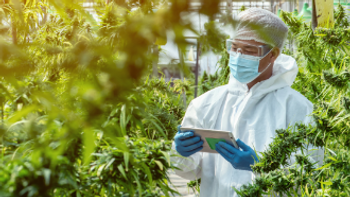
Cannabis Science and Technology
- May 2021
- Volume 4
- Issue 4
Rooting for Recapture and Reuse Impact of Substrate Choices on Irrigation Approach, Watering Rates, and Recirculation Activities

Learn about the major choices of substrate, their benefits and disadvantages, the ways watering volume and frequency are affected by substrate choice, and more.
Learn the major choices of substrate and their benefits and disadvantages, the ways watering volume and frequency are affected by substrate choice, the importance of watering rate and leach percentage and how to calculate them, and implications for water quality, recapture, and reuse.
Growing media impacts the effectiveness of watering for plants, a critical process influencing transpiration and uptake of nutrients. Since the dawn of commercially licensed cannabis cultivation, growers have begun to transition from larger substrate volumes and less efficient watering methods to smaller container sizes and greater integration of more precise irrigation techniques. With high-frequency/low volume irrigation approaches, water efficiency and productivity can be optimized. No matter how water is applied, grower methods can be optimized, and opportunities to increase efficiency of water use across the industry are considerable.
Substrate Choices
Substrate is the base on which plants grow. In commercial food production, soil is the most common substrate. For cannabis, growers often use other media, including rock wool, coconut coir, peat mixed with amendments, or water culture. When selecting a substrate, consider properties such as water retention, recommended irrigation approach, watering rate, leachate percentage, commonly used amendments, and implications for water recapture and reuse to find the right growing media and fertigation methodology.
The most common substrates used for indoor and greenhouse cultivation are described in order of prevalence of use in the legal cannabis market below. A more detailed overview is provided in Cannabis H2O: Water Use and Sustainability in Cultivation, Resource Innovation Institute’s (RII) latest collaborative report with New Frontier Data and the Berkeley Cannabis Research Center (1).
Rock Wool
Rock wool is fibrous material made from molten rock spun into fibers and formed into plugs, blocks, and slabs of various form factors. The sterile nature of production under extreme temperatures keeps the substrate clean and free of pests and pathogens. It is inert; it does not bind any applied water and nutrition. For this reason, it must be frequently irrigated with nutrient solution. Rock wool can deliver very high plant performance, but can require closer monitoring to ensure balanced production. If rock wool irrigation systems malfunction, plants can more quickly and easily experience drought stress or even permanent wilting damage or death.
- Water holding capacity: Rock wool has a high water-holding capacity relative to its volume when compared with other substrates, due to its high volume of air.
- Irrigation approaches: There is a learning curve to using rock wool, especially in the cannabis industry where growers are used to irrigating relatively infrequently. It can be irrigated with varying volumes and frequencies of water in relation to the volume of the substrate, and based on the differing needs of the plants during the cropping cycle.
- Leachate: With uniform fibers and structure, water and nutrient contents can be controlled with minimal leachate. However, because ions are not bound or exchanged on substrate particle surfaces, rock wool can require higher leachate percentage to keep pore water solution elementally balanced and avoid cumulative nutrient imbalances in the plant tissue. Lower leach may be achieved with water culture approaches that recirculate irrigated water.
- Amendments: Rock wool is always used on its own without any amendments, unless for the exception of instances where a rock wool cube is placed atop a coconut coir slab as is common in tomato, cucumber, or pepper greenhouses.
Coconut Coir
Coconut coir is compostable and can be sustainably produced. However, during the manufacturing process coir requires significant volumes of water to buffer the substrate (remove unwanted ions that adsorb to the cation exchange sites). If sodium and other chemicals are not washed from the coir they can negatively impact growth performance. The chemical properties of properly composted, washed, and buffered coir provide an optimal pH range for cannabis cultivation, while having low electrical conductivity, sodium, and potassium content.
- Water holding capacity: Coir can provide excellent water retention, aeration, and drainage under both frequent and less frequent irrigation practices across a variety of container sizes.
- Irrigation approaches: Coir is a very popular growing substrate in the cannabis industry because the physical and chemical properties of coir make it ideal for a range of different irrigation practices, container sizes, environmental conditions, and nutritional strategies.
- Leachate: Minimal leach percentage ranging from 10–25%.
- Amendments: Coir is often used on its own, or mixed with perlite, commonly using a 70% coir–30% perlite ratio.
Peat
Peat mixes are a very wide-ranging category. Peat-based mixes were historically very common in both unregulated and commercial cannabis production. Coir and rock wool have become more popular as they offer growers greater precision when managing substrate.
- Water holding capacity: Peat can hold as high a volume of water as coir, but the portion of nonavailable water is greater, because sphagnum moss fibers are softer than coir, and cannot support as much weight.
- Irrigation approaches: Depending on the inclusion and ratios of amendments, peat may need to be watered less often but at higher volumes. Peat mixes are almost always used with a high percentage of perlite in order to increase aeration, but that also decreases water retention.
- Leachate: No or minimal leachate (10–15% range).
- Amendments: Peat may be amended with various minerals and organic matter, making the mix much denser (200 to 400 g/L) with higher water retention and lower aeration. Inclusion of expanded mineral (like perlite), wood fiber, or aged bark help to maintain proper aeration.
Understanding Watering Rates
The impact of substrate on the frequency and volume of irrigation events is affected by the ratio of substrate volume to plant biomass. A grower might use a large volume of peat that only demands low-frequency irrigation but requires larger volumes of water per event to reach uniform saturation. A different grower may use small volumes of a different substrate that necessitate higher-frequency irrigation events at lower volumes due to the overall lower water-holding capacity.
- Rock wool: Higher-frequency, lower volume. Up to 20 irrigation events a day; frequency and volume depending on the needs of the crop and the volume of the substrate, according to Grodan (the leading producer of rock wool for horticultural use).
- Coir: Moderate frequency, moderate volume. One to 12 water application events a day; frequency and volume depending on the size of the container.
- Peat: Lower frequency, higher volume. One to several water applications a day; volume depending on the aeration of the mix affected by ratio of soil amendments.
- Deep Water Culture: Constant irrigation, low volume. Roots are continually submerged in solution; growers typically top off the solution once or twice a week before a complete solution replacement.
- Aeroponics: Higher frequency, lower volume. Roots are misted extremely frequently (that is, 5 to 15 or more times hourly) with small pulses of nutrient solution.
Water Quality and Recirculation for Sustainability
Growers considering sustainable cultivation approaches should acknowledge the downstream implications of substrate selection on water quality and employ best practices for water management to monitor watering rates, measure leachate percentage, analyze runoff, and support effective treatment and reuse.
Substrate choice is an important factor influencing the treatment and rebalancing activities of reclamation activities. Naturally derived organic substrates such as peat or coir contain carbon and tend to produce an organic-laden leachate that contains a complex mixture of humic acids, tannins, and other polymeric organic compounds. “From a reuse and treatment perspective, these compounds contribute to an increased load on microbial control processes such as oxidant demand and UV disinfection, as well as carbon and sediment filtration processes,” notes RII member Taylor Robinson, Research & Development Manager and Chief Chemist at Silver Bullet Water Treatment. “Organic compounds from naturally derived substrates can also provide a carbon food source for microbial organisms (beneficial, benign, or pathogenic). While certainly not insurmountable, there may be increased cost and infrastructure requirements to ensure proper water quality when managing organic leachate.”
Organic leachate from rock wool substrates is not usually a concern, but because rock wool is a naturally mined product, it may contain naturally occurring metalloids and introduce chemicals into leachate. Commonly, flushing is employed by manufacturers during quality control to remove soluble metals, but soluble arsenic has been observed by Silver Bullet leaching from unused rock wool substrates. Since cannabis is a bio-accumulator, these compounds have a high potential to be stored in plant tissue throughout the cultivation cycle. Testing “hot” for heavy metals is not a nice surprise for a grower, and in some regulated regions, may deem a crop unfit for consumption or sale.
When using deep water culture (DWC) approaches, “well managed hydroponic systems can be purpose-built to reclaim and reuse water, but also run the risk of microbial or pathogen outbreaks,” noted Robinson. Many DWC and aeroponic installations have large groupings of plants with root zones directly connected via piping and the nutrient stream. If the solution is not tested and actively managed, extensive disease outbreaks may be impossible to correct before substantial crop loss occurs.
Growers considering sustainable cultivation approaches should acknowledge the downstream implications of substrate selection on water quality and employ best practices for water management to monitor watering rates, measure leachate percentage, analyze runoff, and support effective treatment and reuse.
Conclusion
Substrate selection is just one of the activities involved in a comprehensive water management plan that addresses fertigation approach, estimation and monitoring of watering rate and leachate percentage, recapture, water quality testing, and rebalancing for recirculation and reuse. Keep an eye out for additional tips for water management in Resource Innovation Institute’s next peer-reviewed
References
https://info.newfrontierdata.com/cannabis-h2o .https://www.sciencedirect.com/topics/agricultural-and-biological-sciences/soil-amendments .
About the Columnist
GRETCHEN SCHIMELPFENIG, PE, is the Technical & Operations Director of RII and facilitates the organization’s Technical Advisory Council, manages the PowerScore resource benchmarking platform, and delivers educational curriculum to the market. She authored the RII Best Practices Guides on
About the Guest Columnist
TAYLOR ROBINSON is the Director of R&D/Analytics for Silver Bullet Water Treatment and Founder of Rimrock Analytical with expertise in molecular and cell biology, general water chemistry, microbiology, and water treatment and reuse processes. Silver Bullet Water Treatment is a member of RII and active in their Technical Advisory Council’s Water Working Group. For the past 6 years, Taylor has led, conceptualized, organized, and completed numerous Silver Bullet research and development projects related to the cannabis, leafy greens, livestock, commercial cooling, aquaculture, and data center industries.
How to Cite this Article
G. Schimelpfenig and T. Robinson Cannabis Science and Technology 4(4), 13-18 (2021).
Articles in this issue
over 4 years ago
New Age Artificial Intelligence for Cannabis Production?over 4 years ago
There’s a Surplus of Hemp in the Market: What Happens in 2021?Newsletter
Unlock the latest breakthroughs in cannabis science—subscribe now to get expert insights, research, and industry updates delivered to your inbox.



